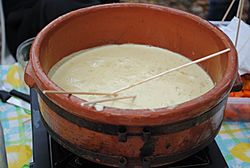Bagna càuda facts for kids

Bagna càuda is kept hot by a small heat source below the dish.
|
|
| Type | Dip |
|---|---|
| Place of origin | Italy |
| Region or state | Piedmont |
| Associated national cuisine | Italian |
| Main ingredients | Garlic, anchovies, olive oil |
Bagna càuda is a tasty hot dip from Piedmont, Italy. Its name means "hot dip" or "hot gravy" in Italian. This special dish is made with garlic and anchovies. It has been a popular food in Italy since the 1500s!
People enjoy Bagna càuda by dipping raw or cooked vegetables into it. It's a bit like fondue, where you dip food into a warm sauce. Sometimes, it's served as a starter before the main meal.
| Top - 0-9 A B C D E F G H I J K L M N O P Q R S T U V W X Y Z |
What is Bagna Càuda?
Bagna càuda is a warm, savory dipping sauce. It is a famous part of Italian cuisine. To make it, cooks use olive oil, chopped anchovies, and lots of garlic. Sometimes, they also add a little salt or even fancy truffles.
The sauce is usually kept warm on the table. A small candle or burner often sits under the dish. This keeps the Bagna càuda hot and ready for dipping.
Where Does Bagna Càuda Come From?
This unique dish comes from Piedmont, a region in Northwest Italy. It has been enjoyed there for hundreds of years. In Piedmont, a plant called cardoon (which is like an edible thistle) is often dipped in the sauce.
But you can dip many other things too! People love to use cabbage, celery, carrots, artichokes, peppers, fennel, and different kinds of bread. It's a great way to eat your veggies!
Bagna càuda is also popular in other parts of the world. You can find it in central Argentina. It's also a favorite in some towns in the United States, like Clinton, Indiana, and Rock Springs, Wyoming. This is because many Italian immigrants moved to these places long ago. They brought their delicious recipes with them!
When is Bagna Càuda Eaten?
This warm dip is traditionally eaten during the cooler months. It's especially popular in autumn and winter. Many families enjoy Bagna càuda during holidays like Christmas and New Year's. Because its name means "hot dip," it must always be served warm.
In the past, people sometimes used walnut oil or hazelnut oil to make Bagna càuda. Today, olive oil is the most common choice.
Similar Dishes
There is another Italian dipping sauce called Pinzimonio. It is similar to Bagna càuda but is usually served cold. Pinzimonio is made with olive oil, wine vinegar, salt, and pepper. It is also enjoyed with raw vegetables.
Images for kids
See also
 In Spanish: Bagna cauda para niños
In Spanish: Bagna cauda para niños


